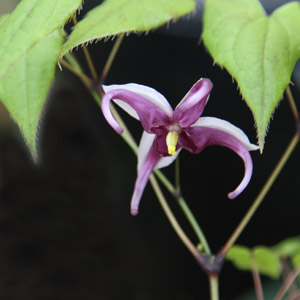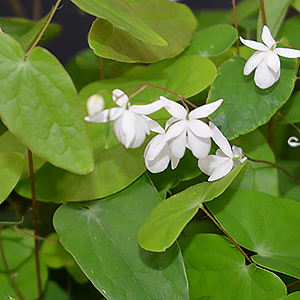
Call them what you will Epimedium, Barrenwort or Bishop’s Hat, Epimediums are a plant that are wonderful shade loving plants.
With around 20 species available for sale in the USA, plus many hybrids, the variety offered by specialist growers grows every year.
However with over 35 species identified in China, more from the Mediterranean and even more believed to be yet discovered the story of Epimediums as garden plants has just commenced.
Epimediums are tough for a dainty looking plant. With flowers ranging from white through to red and lilac in color, and from small and dainty to the large flowering Epimedium grandiflorum.

Flowering in spring, many gardeners cut back the old foliage to help show off the flowers.
However epimediums are also about foliage, the heart shaped bronze / green leaves make a great ground cover in shady positions. They are also mostly avoided by deer, but probably not ‘deer proof’.
So if you are not sure what epimediums are, then follow us as we look at some some of the best of these tough long lived shade loving plants available for sale.
Epimedium Care
Epimediums are easy to grow once they are established. They prefer a cool position, beneath deciduous trees is ideal. Although they will grow in poor soils, they will perform a lot better with a little loving care.
The trick to growing these plants is mulch/leaf litter. They are after all woodland plants and are used to growing in natures compost, leaf litter, which becomes leaf mold.
Fertiliser applied beneath the mulch will also help, use a handful of organic fertiliser before each seasons mulch.
Although these plants grow well in shade, the degree of shade will influence growth. Deep shade is OK however flowering will be less profuse than in semi shade.
As a rule part shade in northern states and deeper shade in southern areas, however light is required for good flowering so avoid really deep shade if you are after flowers.
Planting Epimediums
- Epimediums are best planted in early spring.
- They do require good drainage, they spread by underground rhizomes and poorly drained or water logged soils can quickly kill them off.
- Dig in some well rotted compost.
- Once the new plant has been firmed in they should be watered well with a liquid seaweed fertilizer or vermicaste tea.
- Keep young plants moist through the first summer, after this many Epimediums are reasonably drought tolerant.
Care summary
- Humus rich well drained soil.
- Shade to part shade.
- Growth rate – slow
- Looking at Drought Tolerant Plants in more detail
List of Epimedium Varieties
Epimediums may be evergreen or deciduous depending on species.
- Epimedium sagittatum.
- Epimedium acuminatum
- Epimedium grandiflorum ‘White Queen’.
- Epimedium x versicolor ‘Sulphureum’
- Epimedium diphyllum
- Epimedium franchetti
- Epimedium koreanum
- Epimedium x perralchicum ‘Frohnleiten’
- Epimedium rhizomatosum
- Epimedium x rubrum (red barrenwort)
- Epimedium x warleyense
- Epimedium youngianum ‘Niveum’
- Epimedium x versicolor ‘Cherry Tart’
- Epimedium wushanense
How to Propagate Epimedium
As we mentioned all epimediums grow by underground rhizomes and they will slowly spread. Established clumps can be divided in spring and replanted.
- Dig the clump.
- Using a sharp knife divide into good sized clumps for the garden.
- You can divide into smaller clumps if you are looking at producing masses of these plants.
- Do not worry to much about loosening the root systems as they are generally a tangled matt.
- Dig in some well rotted compost.
- Replant.
- Water in well with a liquid seaweed fertilizer.
- You can also propagate from seed, however this is a lengthy process.
Although they spread, in our experience epimediums are not at all invasive.
Where to buy
GARDEN VISION EPIMEDIUMS – phone 978-249-3863
P.O. Box 50 Templeton, MA 01468-0050
email – gvepimediums@gmail.com
Best selection of Epimedium species/varieties in the U.S. along with a selection of other choice, hard to find shade perennials.
DIGGING DOG NURSERY
PO Box 471 Albion CA 95410 – phone (707) 937-1130
A spectacular selection of hard to find perennials, ornamental grasses, shrubs, trees and vines for your garden. Includes: epimedium frohnleiten, epimedium perralderianum, epimedium grandiflorum.

